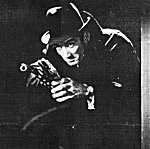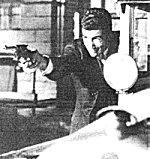I Fought the Law "All you need to make a film is a girl and a gun" | |
 | One of the unforgettable opening film sequences of recent times would have to be that of Goodfellas, where the aging Henry Hill looks back on his induction into the Mafia world with the words "I always wanted to be a gangster...", set to the strains of Tony Bennett belting out 'Rags to Riches'. I don't know whether Dan Treacy had that in mind at all when concocting the new TV Personalities single, with its title 'When I Grow Up I Want to be...' set against a cover image of a machine-gun wielding hoodlum. One of the things which Hollywood cinema has lost, possibly forever, is the ability to make cheap entertainments, usually out of potboiling novels, shot day for night, in a matter of days or weeks, often calling upon actors to improvise their way through thinly-sketched characterizations. These weren't just the stock in trade of 'B' or 'Z'-grade studios such as Poverty Row or Monogram- the bigger studios had their own 'B' units which would prove to be a fertile training ground for future talent, or for directors whose entire careers would remain within the confines of low-budget, frenetic action films with little or no concession to the dictates of realism or continuity. Examples would include titles like 20,000 Years in Sing Sing, featuring one of the snarling, gun-toting villains whose screen presence exudes convention-defying energy and raw impulsiveness. I've lost track of who burnt up the screen in that example of Warner Brothers' 1930's output- a cigar-chomping Edward G. Robinson perhaps, or a young renegade Spencer Tracy. Or was it Cagney? Kevin Pearce has written elsewhere (see the excellent article Angels With Dirty Faces) of his fondness for the gangster films of James Cagney- i've taken that as a cue to ponder some connections leading out of that, and hope to unearth some surprises on the way. Like all good things, the Warner Brothers gangster film cycle eventually came to an end, petering out with a dull thud rather than an explosive catharsis. It was sporadically revived by the occasional shot of adrenaline-fuelled romanticism like Bonnie and Clyde, itself spurred into existence by the French New Wave's incessant homage-paying to the bleak world of black-and-white silhouettes, the fedora and cigarette worn with perfect aplomb. One of the last and best examples prior to that would be The Rise and Fall of Legs Diamond, made in 1960 by one of the masters of the 'B'-movie Budd Boetticher. The rise and fall alluded to in the title arouses interest in its own right, marking it out as a distant cousin to Brecht's experiments with depicting the rise of fascism in terms of gangster mores and an underworld capitalist economy of shady dealings and betrayals. Then there are those legs- in the film they belong to the ceaselessly mobile, lithe figure played by Ray Danton in the film, who works his way from obscurity to king of the underworld through his sharpshooting abilities and, more significantly, his talents as a dancer. Energy and focus, charisma and dandy concern for the details of clothing and image- hat and hair always worn just so. During the course of the film this of course gives rise to all the permutations you'd expect in a subculture populated by thuggery and base contempt for human feelings- when his partner, a pre-Peckinpah Warren Oates, is given the rough treatment as a warning to Diamond, it's his legs which suffer. |
 |
The gangster as balletic figure goes back to the halcyon days of screen depictions of the outlaw- George Raft, made famous by his ability to flip a dime with diabolical insouciance in the original Scarface with Paul Muni and Boris Karloff. The story goes that Al Capone was so impressed by the portrayal that he called him in to his offices to congratulate him. Raft was also impersonated by the svelte Ray Danton in the watered-down treatment of his life-story, appropriately titled Spin of a Coin- the George Raft Story, but with an equally memorable performance by the tragically short-lived Jayne Mansfield. Raft was soon being featured alongside screwball comedy queen Carole Lombard in a piece of salacious fluff called Bolero, once noted for its disarmingly frank sequence where the pair dance the aforesaid bolero, setting the trend for later Hollywood treatments of dirty dancing. Then there's a marvellous story about Cecil Taylor dating back to the 1970's- the maverick Taylor, equal parts adept at dancing and the piano, found in the career of Cagney an invigorating parallel with his own. Cagney's skills stretched to singing and dancing as well as pushing grapefruit into the face of his moll over breakfast, having starred in one of the outrageous Busby Berkeley-choreographed musical extravaganzas. Once seen never forgotten stuff, featuring eye-popping routines marshalling row upon row of scantily-clad chorines, aspiring starlets used to provide symmetrical shapes illustrating Depression-era songs like 'In the Money'. Taylor's performance style is about pushing an initial premise to its furthest extreme, subjecting the audience's ears and his own body to a vicious pummelling, single pieces lasting anywhere between 30 seconds and an hour, thereby combining rare feats of endurance of concentration and muscular and aerobic activity. By this point however, disillusioned in part no doubt by the frequent bouts of racist prejudice which he encountered, he developed a yearning to portray Cagney the hoofer in a ballet choreographed by Mikhail Baryshnikov. As far as i'm aware this project never got off the ground, but it stands as a favourite example of music intersecting with a fascination for silver screen heroics. Quite apart from Noel Coward writing 'Mad About the Boy' in response to Cagney's unstoppable verve ("although i'm quite aware that here and there are traces of the cad about the boy"), the no compromise stance and ability to fire out rat-tat-tat dialogue would be the inspiration for Public Enemy's own eulogy in rap form. |
 |
One of the things about Prohibition-era life was its bigger-than-life appeal. On your way out of the cinema, you could encounter mobster John Dillinger, about to be gunned down after seeing a film featuring his favourite star Myrna Loy. Then there's tough-as-nails folkster Leadbelly and his hot-off-the-presses ode to Jean Harlow after her untimely death. This isn't the place for a Hollywood Babylon-style expose of the circumstances behind Harlow's demise- suffice to mention the iconic importance of her bleach-blonde look in roles which sent the censors into a tizzy, in films like Red Dust or Red Headed Woman, for which she followed the title's cue and became a fiery redhead. Much as i'd like to expatiate Robert Forster-style on the benefits of Redken over hydrogen peroxide, film stars and hair-care concerns stretch to other film noir icons. It was of course the Go-Betweens who went for "a swim in Veronica Lake", launching a posthumous career in pop music for the woman who mesmerized audiences alongside Alan Ladd in such films as the Chandler-scripted The Blue Dahlia. Maybe someone could trace the fortunes of her namesake band in an article, but for the moment i'm left with the enduring image of her temptress locks, imitated throughout the US in the '40s, to the extent that working women were getting their imitation peek-a-boo bangs caught in factory machinery. At this point Lake intervened and publicly sported a shorter, and safer, haircut. Her husband, the one-eyed Hungarian tough-guy director Andre de Toth, was also no stranger to courting controversy and holding his own against overpaid screen heavyweights. Not only did he make his reputation with his skills at directing House of Wax in 3D (with one eye, the mind boggles), but took a far more courageous and realistic line in tackling drug addiction on film. His film Monkey on my Back goes for the jugular in a way only hinted at in other efforts of the period- the story told there of the returning soldier addicted to morphine became the basis of John Prine's wonderful ballad 'Sam Stone' on his eponymous Atlantic debut lp. Featuring the line "there's a hole in his arm where all the money goes", it's a no-holds-barred, emotionally-charged account of social alienation and clinging on for dear life in the face of the abyss. Stripping the heroics away from the subject-matter, Prine's words and music linger with their forceful, unflinching gaze into the gutter. © Marino Guida 1999 |